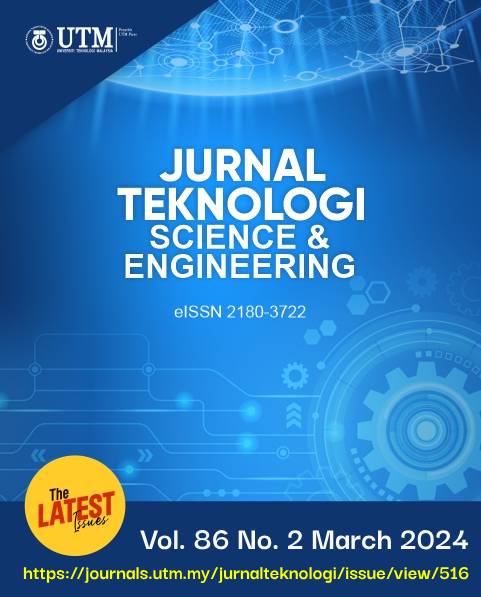ACIDIC-ENZYMATIC CO-TREATMENT OF FOOD WASTE FOR HIGH SUGAR RECOVERY AND BIOGAS PRODUCTION
DOI:
https://doi.org/10.11113/jurnalteknologi.v86.19348Keywords:
Acidic-enzymatic treatment, biogas from food-waste, solid state fermentation enzyme, reducing sugar, biological treatmentAbstract
Food-waste (FW) has a high content of fermentable sugar which can be exploited to generate an alternative source of fuel that could replace fossil fuels. Anaerobic digestion (AD) is an approach to convert organic-waste into high-value products like biomethane and hydrogen. However, hydrolysis is deemed to be a rate-limiting process in the AD process, limiting biogas production. This study seeks to improve the hydrolysis process through pre-treating FW with chemical and biological treatments. We show that the enzymatic treatment substantially improved the hydrolyzation and solubilization of food waste, resulting in a three folds increase in biogas production compared to untreated food waste. A co-treatment of biological and enzymatic treatments significantly improved the hydrolysis process, solids reduction, and solubilization of the substrate. The soluble chemical oxygen demand (SCOD) and reducing sugar were increased by 50% and 25% respectively, compared to enzymatically treated only. However, the inhibitory effect of accumulated salts from the treatment has limited the application of anaerobic digestion. Our results reveal that using enzymatic and acidic pre-treatment can significantly enhance hydrolysis of FW to increase biogas production, highlighting the potential of AD.
References
K. Paritosh, S. K. Kushwaha, M. Yadav, N. Pareek, A. Chawade, and V. Vivekanand. 2017. Food Waste to Energy: An Overview of Sustainable Approaches for Food Waste Management and Nutrient Recycling. BioMed Research International. 2017. Doi: 10.1155/2017/2370927.
H. I. Abdel-Shafy and M. S. M. Mansour. 2018. Solid Waste Issue: Sources, Composition, Disposal, Recycling, and Valorization. Egyptian Journal of Petroleum. 27(4): 1275-1290. Doi: 10.1016/j.ejpe.2018.07.003.
H. C. Moon et al. 2009. Enzymatic Hydrolysis of Food Waste and Ethanol Fermentation. Int J Energy Res. 33(2): 164-172. Doi: 10.1002/er.1432.
E. Uçkun Kiran, A. P. Trzcinski, and Y. Liu. 2015. Enhancing the Hydrolysis and Methane Production Potential of Mixed Food Waste by an Effective Enzymatic Pretreatment. Bioresour Technol. 183: 47-52. Doi: 10.1016/j.biortech.2015.02.033.
H. Guo et al. 2021. Reconsidering Hydrolysis Kinetics for Anaerobic Digestion of waste Activated Sludge Applying Cascade Reactors with Ultra-short Residence Times. Water Res. 202. Doi: 10.1016/J.WATRES.2021.117398.
K. Paritosh, S. K. Kushwaha, M. Yadav, N. Pareek, A. Chawade, and V. Vivekanand. 2017. Food Waste to Energy: An Overview of Sustainable Approaches for Food Waste Management and Nutrient Recycling. Biomed Res Int. Doi: 10.1155/2017/2370927.
L. X et al. 2020. Applying Potentials to Conductive Materials Impairs High-loading Anaerobic Digestion Performance by Affecting Direct Interspecies Electron Transfer. Bioresour Technol. 297. Doi: 10.1016/J.BIORTECH.2019.122422.
O. Parthiba Karthikeyan, E. Trably, S. Mehariya, N. Bernet, J. W. C. Wong, and H. Carrere. 2018. Pretreatment of Food Waste for Methane and Hydrogen Recovery: A Review. Bioresour Technol. 249: 1025-1039. Doi: 10.1016/j.biortech.2017.09.105.
H. C. Moon and I. S. Song. 2011. Enzymatic Hydrolysis of FoodWaste and Methane Production Using UASB Bioreactor. International Journal of Green Energy. 8(3): 361-371. Doi: 10.1080/15435075.2011.557845.
E. Uçkun Kiran, A. P. Trzcinski, and Y. Liu. 2015. Enhancing the Hydrolysis and Methane Production Potential of Mixed Food Waste by an Effective Enzymatic Pretreatment. Bioresour Technol. 183: 47-52. Doi: 10.1016/j.biortech.2015.02.033.
B. T. Hedge, J E and Hofreiter. 1962. Carbohydrates Chemistry. Academic Press.
C. V. Sapan and R. L. Lundblad. 2015. Review of Methods for Determination of Total Protein and Peptide Concentration in Biological Samples. Proteomics Clin Appl. 9(3-4): 268-276. Doi: 10.1002/PRCA.201400088.
Min, D. B., Ellefson, W.C. 2010. Fat Analysis. In: Food Analysis. Springer, Boston, MA. https://doi.org/10.1007/978-1-4419-1478-1_8.
S. Hadjarab, A. Zahangir, F. Yusof, and A. Elgharbawy. 2023. Identification and Optimization from Enzymes Extracted by Solid-State Fermentation. Journal of Agrobiotechnology. 14(2): 12-27. https://doi.org/10.37231/jab.2023.14.2.304.
I. Angelidaki and W. Sanders. 2004. Assessment of the Anaerobic Biodegradability of Macropollutants. Rev Environ Sci Biotechnol. 3(2): 117-129. Doi: 10.1007/S11157-004-2502-3/METRICS.
J. E. Reeb, M. R. Milota, W. D. K. Association, and Or. 1999. Western Dry Kiln Association. Moisture Content by the Oven-dry Method for Industrial Testing. Proceedings Papers from the annual meetings of the Western Dry Kiln Association and Its Predecessor. The Western Dry Kiln Clubs. 66-74.
O. Ernst and T. Zor. 2010. Linearization of the Bradford Protein Assay. J Vis Exp. 38. Doi: 10.3791/1918.
Jain, A., Jain, R., Jain, S. 2020. Quantitative Analysis of Reducing Sugars by 3, 5-Dinitrosalicylic Acid (DNSA Method). In: Basic Techniques in Biochemistry, Microbiology and Molecular Biology. Springer Protocols Handbooks. Humana, New York, NY. https://doi.org/10.1007/978-1-4939-9861-6_43.
D. G. Abernathy, G. Spedding, and B. Starcher. 2009. Analysis of Protein and Total Usable Nitrogen in Beer and Wine Using a Microwell Ninhydrin Assay. Journal of the Institute of Brewing. 115(2): 122-127. Doi: 10.1002/J.2050-0416.2009.TB00356.X.
R. Chavan, K. Saxena, and D. Tigote. 2015. Optimization of Acid Hydrolysis Process for Free Glucose Recovery from Starch. International Journal of Innovative Science, Engineering & Technology. 2(12): 55-58.
S. A. Braham et al. 2021. Effect of Concentrated Salts Solutions on the Stability of Immobilized Enzymes: Influence of Inactivation Conditions and Immobilization Protocol Molecules. 26(4). Doi: 10.3390/MOLECULES26040968.
K. Talley and E. Alexov. 2010. On the pH-optimum of Activity and Stability of Proteins. Proteins. 78(12): 2699. Doi: 10.1002/PROT.22786.
J. Speda, M. A. Johansson, A. Odnell, and M. Karlsson. 2017 Enhanced Biomethane Production Rate and Yield from Lignocellulosic Ensiled Forage Ley by In Situ Anaerobic Digestion Treatment with Endogenous Cellulolytic Enzymes. Biotechnol Biofuels. 10(1): 1-13. Doi: 10.1186/S13068-017-0814-0/FIGURES/6.
N. Anwar et al. 2016. Effect of Sodium Salt on Anaerobic Digestion of Kitchen Waste. Water Science and Technology. 73(8): 1865-1871. Doi: 10.2166/WST.2016.035.
Downloads
Published
Issue
Section
License
Copyright of articles that appear in Jurnal Teknologi belongs exclusively to Penerbit Universiti Teknologi Malaysia (Penerbit UTM Press). This copyright covers the rights to reproduce the article, including reprints, electronic reproductions, or any other reproductions of similar nature.
















